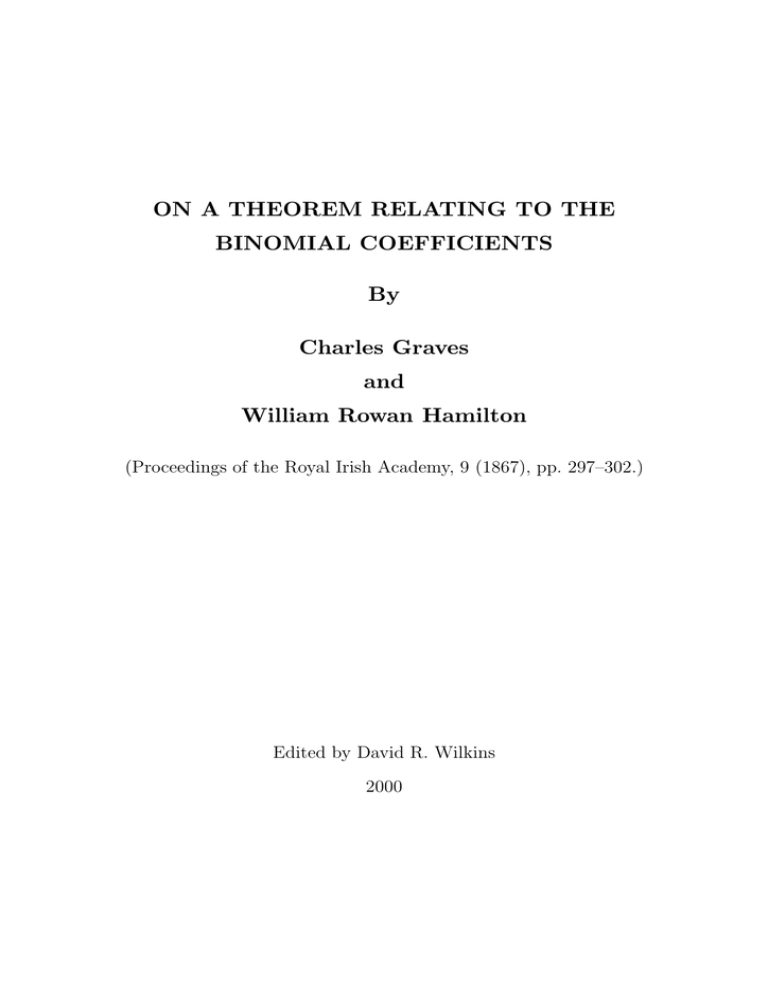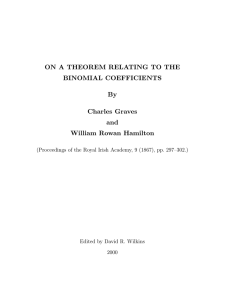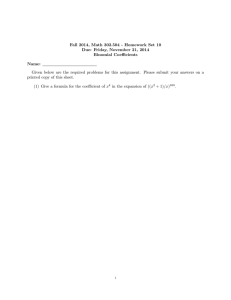ON A THEOREM RELATING TO THE BINOMIAL COEFFICIENTS By Charles Graves
advertisement

ON A THEOREM RELATING TO THE BINOMIAL COEFFICIENTS By Charles Graves and William Rowan Hamilton (Proceedings of the Royal Irish Academy, 9 (1867), pp. 297–302.) Edited by David R. Wilkins 2000 ON A THEOREM RELATING TO THE BINOMIAL COEFFICIENTS. Charles Graves and Sir William Rowan Hamilton. Communicated 26 June, 1865. [Proceedings of the Royal Irish Academy, vol. ix (1867), pp. 297–302.] The President read the following paper, with a Note by the late Sir W. R. Hamilton, LL.D.:— On a Theorem relating to the Binomial Coefficients. Towards the end of March, I communicated the following theorem to Sir William Rowan Hamilton:— Putting s0 = n0 + n3 + n6 + &c., s1 = n1 + n4 + n7 + &c., s2 = n2 + n5 + n8 + &c., where n0 , n1 , &c., are the coefficients of the development (1 + x)n = n0 x0 + n1 x1 + n2 x2 + &c., and n is a positive whole number; we shall find that, of the three quantities s0 , s1 , s2 , two are always equal, and the third differs from them by unity. I mentioned at the same time that I had arrived at theorems, analogous, but less elegantly expressed, by summing the series formed by taking every fourth or fifth coefficient, and so on, in the binomial development; and I asked Sir William R. Hamilton whether he remembered to have seen these theorems stated anywhere. I thought it likely that the well-known elementary theorem respecting the equality of the sums of the alternate coefficients in the binomial development would have suggested research in this direction. In a note, written on the day on which he received mine, Sir William stated that my theorem was new to him, and that he had proved it by the help of imaginaries and determinants. The following day he wrote again to me, furnishing me with the following more precise statement of my theorem:— 1 “Let ν and N be the following (whole) functions of n, ν = (−1)n , N = 13 (2n − ν); then N , N and N + ν are always the value of the three sums, if suitably arranged; and the singular sum is s0 , or s1 , or s2 , according as n, or n + 1 or n + 2 is a multiple of 3.” I communicated the following demonstration of my theorem to Sir William, in a letter of the 29th March:— Using the notation employed above, we know that (n + 1)r = nr + nr−1 , (n + 1)r−1 = nr−1 + nr−2 , and (n + 1)r − (n + 1)r−1 = nr − nr−2 . Now, putting sr = . . . + nr−m + nr + nr+m + . . . , s0r = . . . + (n + 1)r−m + (n + 1)r + (n + 1)r+m + . . . , (m being any positive integer), we have, from equation (1.), s0r − s0r−1 = sr − sr−2 ; and, in the particular case under consideration, viz. m = 3, s02 − s01 = s2 − s0 , s01 − s00 = s1 − s2 , s00 − s02 = s0 − s1 . Thus it appears that the differences of the quantities s00 , s01 , s02 , are equal in magnitude, but of opposite signs to those of s1 , s2 , s0 ; and if we form these differences for successive values of n, they will arrange themselves in a cycle of six. Thus, if s 2 − s 1 = ∆0 , s 1 − s 0 = ∆2 , s 0 − s 2 = ∆1 , we might form the following Table. n ∆0 ∆2 ∆1 1 2 3 4 5 6 7 8 ... −1 −1 0 1 1 0 −1 −1 ... 0 1 1 0 −1 −1 0 1 ... 1 0 −1 −1 0 1 1 0 ... Combining this result with the well-known theorem— s 0 + s 1 + s 2 = n0 + n1 + n2 + . . . = 2n , we arrive at formulae for s0 , s1 , s2 . 2 A couple of days later, I communicated to Sir William Hamilton my statement and proof of the corresponding theorem respecting the four sums obtained by adding every fourth binomial coefficient. The theorem is as follows:— “Writing ν = (−1)i where i is any positive integer, If n is of the form 4i, n−2 s0 = 2n−2 + ν2 2 , s1 = 2n−2 , s2 = 2n−2 − ν2 n−2 2 , s3 = 2n−2 ; If n is of the form 4i + 1, s0 = 2n−2 + ν2 n−3 2 s1 = 2n−2 + ν2 n−3 2 s2 = 2n−2 − ν2 n−3 2 s3 = 2n−2 − ν2 n−3 2 , , , ; If n is of the form 4i + 2, s0 = 2n−2 , s1 = 2n−2 + ν2 n−2 2 , s2 = 2n−2 , s3 = 2n−2 − ν2 n−2 2 ; If n is of the form 4i + 3, s0 = 2n−2 − ν2 n−3 2 s1 = 2n−2 + ν2 n−3 2 s2 = 2n−2 + ν2 n−3 2 s3 = 2n−2 − ν2 n−3 2 , , , .” The proof of this rests upon the equations s03 − s02 = s3 − s1 , s02 − s01 = s2 − s0 , s01 − s00 = s1 − s3 , s00 − s03 = s0 − s2 , combined with s0 + s1 + s2 + s3 = 2n . 3 Though the theorems which I have now stated or indicated are not devoid of interest, I should hardly have brought them under the notice of the Academy if they had not led Sir William R. Hamilton to discuss the more general question treated of in the Note appended to this paper. It is at his suggestion that I have communicated the substance of the letter which I addressed to him on this subject. I may be allowed to add, that the first theorem stated in this paper was suggested by the investigation of a very simple geometrical problem, and that I have found that it admits of being very curiously illustrated by means of my theory of algebraic triplets. Extract from a recent Manuscript Investigation, suggested by a Theorem of Dean Graves, which was contained in a letter received by me a week ago. 1. Let nr , for any whole value not less than zero of n, and for any whole value of r, be defined to be the (always whole) coefficient of the power xr , in the expansion of (1 + x)n for an arbitrary x; so that we have always n0 = 1, but nr = 0 in each of the cases r < 0, r > n. 2. Let p be any whole number > 0; and let the sum of all the coefficients nm , for which m ≡ r (mod. p), the value of n being given, by denoted by the symbol, s(p) n,r ; which thus represents, when n and p are given, a periodical function of r, in the sense that (p) s(p) n,r = sn,r+tp , if t be any whole number (positive or negative). 3. A fundamental property of the binomial coefficient nr is expressed by the equation, (n + 1)r = nr + nr−1 ; from which follows at once this analogous equation in differences, (p) (p) sn+1,r = s(p) n,r + sn,r−1 ; with the p initial values, (p) s0,0 = 1, (p) s0,1 = 0, (p) s0,2 = 0, ..., 4. Hence may be deduced the general expression, −1 s(p) Σx−r (1 + x)n ; n,r = p 4 (p) s0,p−1 = 0. in which the summation is to be effected with respect to the p roots x of the binomial equation, xp − 1 = 0. 5. The summand term, x−r (1 + x)n , usually involves imaginaries, which must however disappear in the result; and thus the general expression for the partial sum, s, may be reduced to the real and trigonometrical form, s(p) n,r −1 =p n mπ m(n − 2r)π , Σ 2 cos cos p p with the verification that n mπ m(n − 2r)π 0 = Σ 2 cos ; sin p p each summation being performed with respect to an auxiliary integer m, from m = 0 to m = 1. 6. Accordingly, without using imaginaries, it is easy to prove that this expression (5) satisfies all the recent conditions (3), and is therefore a correct expression for the partial sum s(p) n,r ; while a similar proof of the recent equation 0 = &c. 7. But to form practically, with the easiest possible arithmetic, a Table of Values of s, for any given period, p, we are led by No. 3 to construct a Scheme, such as the following: n=0 1 2 3 4 5 6 r=5 4 3 2 1 0 Verification s=1 1 1 1 1 2 7 0 0 0 0 1 5 15 0 0 0 1 4 10 20 0 0 1 3 6 10 15 0 1 2 3 4 5 7 1 1 1 1 1 2 7 Σs = 1 2 4 8 16 32 64 5






